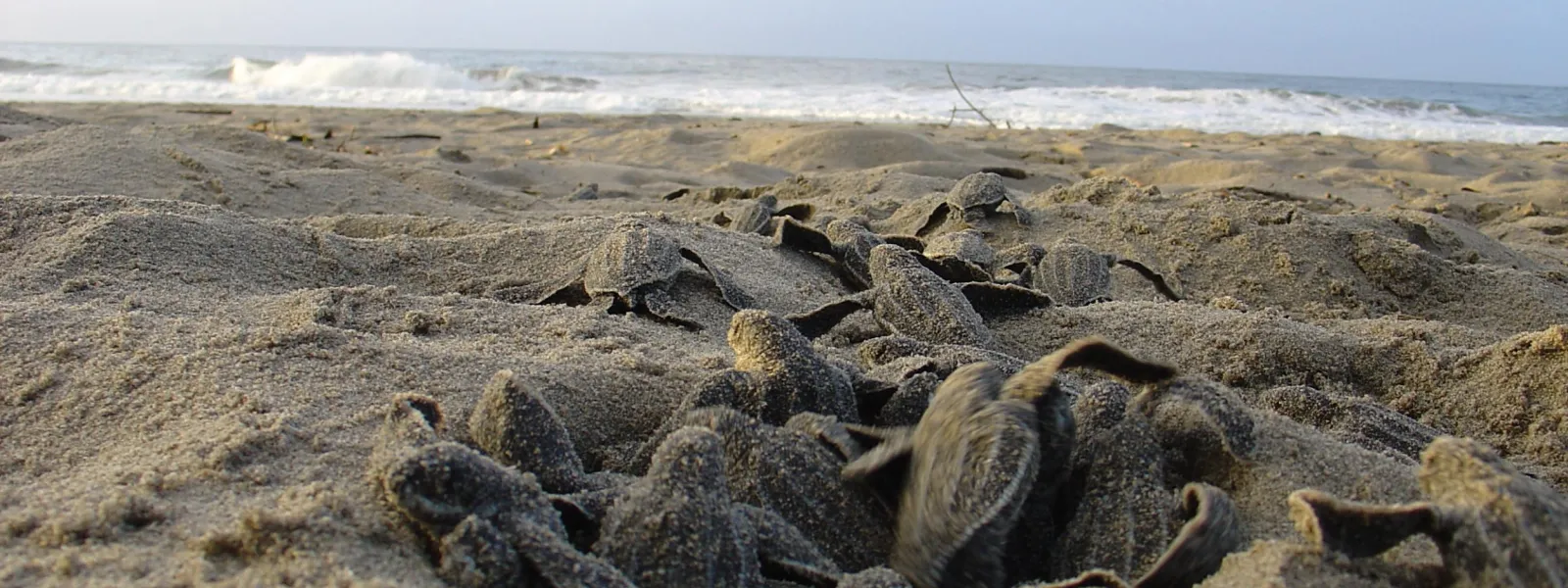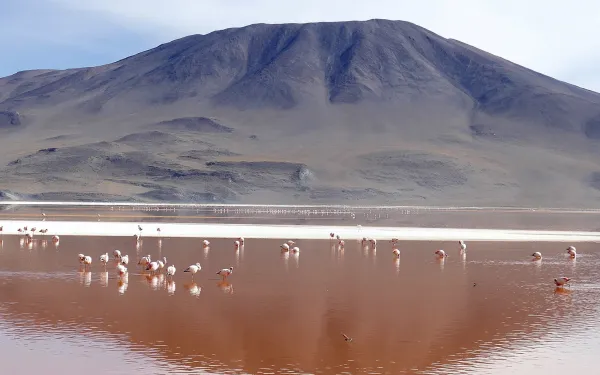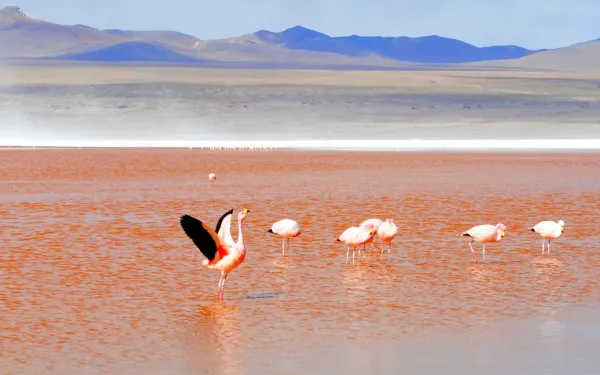
Project
Victory: Haven for leatherback sea turtles declared off-limits
In two separate rulings in May 2008, the Costa Rican government stood up for endangered leatherback sea turtles against business interests intent on building within their protected habitat.
A relative of dinosaurs, the endangered leatherback sea turtle has continually found its home in Costa Rica under threat. Poor planning and lack of oversight destroyed its nesting beaches in Flamingo and Tamarindo.
This time developers had their eye on the Leatherback National Marine Park (LNMP), home to some of the most important Leatherback nesting beaches in the Eastern Pacific Ocean.
A municipal zoning regulation was enacted that would authorize construction in part of the LNMP. However, AIDA and its local partner CEDARENA, together with the Leatherback Trust, successfully defended the park.
The Constitutional Chamber of the Costa Rican Supreme Court nullified the municipal zoning regulation, safeguarding the Leatherback sea turtles and their nesting beaches. This ruling closely followed another court victory by AIDA, CEDARENA, and Justice for Nature that required the government to expropriate the private lands within the LNMP, otherwise destined to be tourist playgrounds.
The leatherback sea turtle will continue to face threats from tourism development, fishing, egg poaching, and pollution. However, AIDA and its partners have shown that the law can be used to make a powerful difference.
Related projects

“Choose Europe”: Prioritizing minerals, not rights
The Raw Materials Week in Brussels, Belgium, has come to an end. This annual event, organized by the European Commission, aims to discuss how to ensure "sustainable and secure" access to raw materials in and for Europe, with the goal of strengthening international alliances to meet its defense, digitalization, and security goals.The European Commission emphasized that Europe is highly dependent on mineral imports from Latin America, which deepens the region’s historical pressures and the resulting need for stronger socio-environmental protections. However, from the Andean Wetlands Alliance, we maintain the week’s debates revealed an approach increasingly disconnected from human rights, community voices, and the global socio-environmental crisis.This shift in priorities is part of a broader political turn marked by geopolitical tensions around access to critical minerals and new energy sources, as well as by the rise of conservative forces and authoritarianism. A trend is emerging within the EU toward the privatization of human rights and environmental standards, along with the weakening of social and environmental safeguards through deregulatory processes. An example of this is the debate on the possible weakening of the Corporate Sustainability Due Diligence Directive.The dominant narrative this week was shaped by concepts such as “competitiveness” and “defense” as the guiding axes of European policies. Within the framework of a geopolitical rivalry between China and the United States, Europe seeks to reduce its dependence on its long-standing Western ally under the slogan “Choose Europe,” which titled this year’s edition. In this context, the European Commission continued to promote access to minerals through an approach centered on the security of its supply chains, without assessing its policies in light of planetary boundaries or human rights. This approach contradicts the commitments associated with the energy transition that originally motivated the discussions on “critical minerals.” Today, we ask to what extent the cost of “choosing Europe” will continue to be borne by local communities in Latin America and other peripheral regions affected by mining expansion.Today, we ask to what extent the cost of "choosing Europe" will continue to be borne by local communities in Latin America and in other peripheral regions affected by mining expansion.This edition had the least debate compared to the last years on the need to integrate human rights into European mineral policies. Indeed, accreditation for access to the official event was limited, and the forum's official agenda lacked a space for communities and civil society from the Global South to express their perspectives on mineral value chains like lithium, and to influence the debates that will shape the decisions affecting them. Instead, discussions focused primarily on investment opportunities for corporations and governments.From the Andean Wetlands Alliance, we highlight that the expansion of the extractive frontier contradicts the climate and biodiversity commitments endorsed by the EU and risks deepening existing asymmetries between the two regions. For this reason, we reaffirm our position on the need for a paradigm shift in EU raw materials policies, so that they become inclusive, transparent, and sustainable, ensuring the participation of communities and organizations located at the extractive frontier of transition minerals. Likewise, in the context of the ecological and democratic polycrisis, we stress the need for the EU to adopt concrete targets to effectively reduce mineral demand and to strengthen compliance with international human rights and environmental treaties.Press KitPress contactsVíctor Quintanilla, AIDA (regional), [email protected], +521 5570522107Rocío Wischñevsky, FARN (Argentina), [email protected], +541159518538Manuel Fontenla, Asamblea PUCARÁ (Argentina), [email protected], +54 9 3834790609Oscar Campanini, CEDIB (Bolivia), [email protected], +591 70344801Juan Francisco Donoso, Formando Rutas, [email protected], +4915780743628
Read more
The home stretch of COP30: Shadows, contradictions, and some glimmers of hope
The first week is over, and the political phase of the 30th United Nations Climate Change Conference (COP30) has begun in Belém do Pará, Brazil. These are the days when decisions must be made.A COP had not been held in a country where public protest is possible since 2021 — and people have certainly made their voices heard. On Saturday, a massive demonstration took place: thousands demanded climate justice in the streets, to the rhythm of Amazonian drums. There was also a theatrical "funeral for fossil fuels," reminiscent of Tim Burton, with monsters and somber widows bidding farewell to an era that must be buried.But it has not all been carnival. Indigenous leaders blocked access to the event several times and even entered the "blue zone" — the restricted area — en masse, denouncing the exploitation of their territories. Their discontent is absolute. Although COP authorities met with the group, they soon sent a letter to the Brazilian government requesting increased security and the dispersal of protests. Human rights and environmental organizations have warned about the risks of criminalizing protest and the harmful message this sends about the role of Indigenous peoples.These protests reflect communities that ended up being a minority in an event that promised to be inclusive. There was also widespread criticism of the disproportionately large number of fossil fuel industry representatives involved in negotiations — a dynamic that makes the path toward climate justice even more complicated.Finally, advisory opinions (AOs) must not be left out of this review. While not formally on the agenda, they have made a strong impact. Their central message is powerful: international cooperation is not optional — it is a legal obligation. It is no surprise, then, that the theme keeps resurfacing: in side events, in constant references by civil society and some national delegations, and in cross-cutting mentions across debates on finance, adaptation, and transition. The AOs are not merely being cited; they are being embraced. Momentum is building to fully unleash their potential at this COP and beyond. Negotiations: Four key issues in “presidential consultations”The COP Presidency acted quickly with a novel approach: to adopt the agenda without delays, it set aside four complex issues and moved them into “presidential consultations.”Article 9.1 — Public Funding from Developed Countries. The debate centers on whether climate financing should come only from public sources or also from private sources, as well as on accountability and reporting standards. Developed nations — which are legally obligated to provide this financing — are resisting, while vulnerable countries urgently need the funds to survive the climate crisis.Unilateral Climate-Related Trade Measures. These include policies such as carbon border taxes. They are considered unfair or protectionist, especially by Global South countries with less capacity to reduce emissions. Negotiations aim to prevent arbitrary trade barriers while respecting climate action.NDCs and Ambition. According to the latest NDC synthesis report, there is a significant gap between current commitments and what is required to stay below 1.5°C. Many negotiators argue that agreeing on concrete measures to close that gap is essential, but large emitters continue to resist.Synthesis of Climate Transparency Reports. Under the Paris Agreement’s Enhanced Transparency Framework, countries must periodically report emissions, actions taken, and financial support provided or received. At COP30, the debate centers on how to make these synthesis reports more robust, comprehensive, and useful. The consultations have been tense and slow. On Sunday, the Presidency published a "summary note" outlining possible pathways, and today a draft decision was released, though reactions are still forthcoming. In the coming days, closed-door sessions will continue and could lead to various outcomes. Based on the draft, it seems increasingly likely that COP30 will end with a “cover decision” consolidating all progress and addressing these complex matters. The final scope will depend heavily on what happens during the next four days. A just energy transition: Promises and a mechanism that worksThe Belém Action Mechanism for a Just Transition is a new institutional arrangement under the UNFCCC, championed by NGOs and Global South countries. Its objective is to bring order to the currently fragmented landscape of just transition efforts. The mechanism would coordinate initiatives, systematize knowledge, and provide quality financing and support — essentially evolving the Just Transition Work Program discussed since COP27.Civil society, particularly the Climate Action Network (CAN), has invested enormous effort in developing a strong decision that advances the creation of this mechanism. The G77 + China — the largest negotiating bloc of developing countries — supported this proposal, earning CAN’s "Ray of Light" award, given to actors making significant contributions to climate justice.Some developed countries presented less ambitious proposals, but even that confirms that convergence is drawing closer. Civil society remains optimistic that a concrete, positive outcome will be achieved — and ready to celebrate it. A path to phase out fossil fuelsThis story began in 2023 at COP28 in Dubai, when, for the first time, the idea of phasing out fossil fuels appeared in an official COP text.Now, at the opening of COP30, Brazilian President Luiz Inácio Lula da Silva explicitly referenced a "route" for the energy transition, while Environment Minister Marina Silva has worked to reinforce the political momentum. Meanwhile, Colombia issued a declaration referencing the advisory opinions and seeking international support for the initiative. Several industrialized countries have revived their position through the Beyond Oil and Gas Alliance.Today, 63 countries support a commitment to "Transition Away from Fossil Fuels." However, this is not yet part of the formal negotiation agenda — initiatives remain fragmented, and efforts proceed in parallel. What could emerge is a concrete action plan, a dedicated section in the final decision, or perhaps a roadmap for a future roadmap. The alternative is that it remains a voluntary coalition of willing countries pushing the idea forward. Climate finance: The central — and most complicated — issueFinance remains the central issue at this COP, and perhaps the most complex. Several deeply interconnected discussions are underway:Article 9.1: Developing countries insist that public financing from developed nations is a binding obligation that cannot be replaced by private investment.Adaptation: A strong consensus is forming to triple the adaptation finance goal (to about USD 120 billion annually) while improving transparency and direct access to funds.The Baku–Belém Roadmap: This initiative seeks to scale up global climate finance to USD 1.3 trillion per year by 2035 through a combination of public, multilateral, and private flows.Loss and Damage Facility: The fund is technically operational but not fully capitalized. New contributions from Spain and Germany are welcome — but insufficient to meet global needs.Tropical Forests Forever Facility: Brazil has proposed this as an “investment model” for tropical forest countries. Civil society has expressed serious concerns: the model depends heavily on volatile market investments and lacks safeguards to ensure the protection of local communities and ecosystem integrity. Adaptation progress, but under the shadow of chronic underfundingDiscussions on adaptation are unfolding on two parallel fronts:Indicators for the Global Goal on Adaptation. Ten years after the Paris Agreement, there is still no consensus on how to track adaptation progress. A working group narrowed approximately 9,000 proposed indicators down to about 100, but technical and political challenges persist. Some African and Arab countries have asked to postpone final adoption until they have the financial resources and capacity to implement them. A prevailing sentiment is: "no indicators without funding" — adopting metrics without support would repeat past mistakes.Adaptation finance. Although adaptation financing is not formally included within the Global Goal on Adaptation, the two issues are inseparable. Without adequate financial support, indicators alone will be ineffective. Following the agreement on a new climate finance goal at COP29, the current debate focuses on aligning that goal with adaptation needs — especially through technology transfer, capacity building, and direct-access funding channels. Substantial gaps remain, and negotiations continue to hinge on how to categorize financial flows (private vs. public, domestic vs. international).
Read more
Justice for Andean Wetlands and Indigenous Peoples in Climate Action
The growing global demand for transition minerals—including lithium, copper, and nickel—driven by the current energy transition model, but also by the expansion of the digital economy, data infrastructure, and the military and aerospace industries, is causing irreversible ecological damage and violating fundamental human rights across the territories of the Global South. Latin America is the most biodiverse region on the planet and one of the most culturally diverse regions in the world. It is home to numerous Indigenous peoples who inhabit and safeguard these territories.At the same time, the region holds significant mineral deposits, placing it at the center of the growing global interest in mineral extraction. This demand intersects with fragile ecosystems, unique biodiversity and the territories of traditional and Indigenous communities, including the Amazon and the high Andean wetlands, which are crucial for climate adaptation due to their role in water regulation, and in mitigation, as they act as carbon sinks.Intensive mining in these ecosystems exacerbates climate vulnerability and fosters socio-environmental conflicts, compromising the ecological and cultural integrity of these ecosystems and communities. The push to expand extraction contradicts multilateral environmental protection frameworks and the climate and biodiversity commitments adopted by the States Parties. This trend jeopardizes the possibility of a just and equitable transition, reproducing the same patterns of inequality and climate harm that current policies claim to overcome. In this context, the Alliance for Andean Wetlands calls on States Parties to the UNFCCC to ensure: 1. Human rights and justice must be at the center of any transition and of all strategies for climate change adaptation and mitigation, including the rights of communities living in territories where the transition minerals are located.Human rights are essential to ensuring a just, equitable and people-centred process. States must guarantee the right to self-determination of Indigenous peoples, recognized worldwide as guardians of natural systems. This must encompass their right to define their own development priorities and to exercise Free, Prior and Informed Consent (FPIC), as well as the unequivocal obligation of States to respect their decisions, particularly their right to say “no” to projects that threaten their integrity and that of their territories. States must also ensure protection of environmental defenders, and guarantee public access to information, participation and justice on decisions about transitions that might affect the environment and human rights. These guarantees are crucial for the case of so-called transition minerals, like lithium and copper, found in the high Andean wetlands, ecosystems that are fundamental to life, ecological and climate balance, and the livelihoods of the communities that inhabit them. 2. Respect of planetary boundaries and the protection of the integrity of ecosystems, particularly those that play essential roles in climate adaptation and mitigation.Keeping ecosystems such as Andean wetlands, which are of high ecosystemic and cultural value, free from high-impact activities is a priority for climate and ecological justice. Because lithium mining is water mining, it drains already scarce water sources and severely affects surrounding ecosystems, leaving lasting environmental damage.To preserve the high Andean wetlands and their contributions on which life in the region and on the planet depends, States must fully respect and comply with international environmental law; adopt and strengthen effective protection measures (including the establishment of “no-go zones”, protected areas, ICCAs); and apply robust and science-based environmental planning instruments that seek to prevent environmental damage (i.e. environmental strategic and cumulative impact assessment, environmental impact assessment).Effective environmental protection also requires up-to-date knowledge of ecosystem structure, functioning, and contributions, developed through collective and democratic processes, integrating traditional knowledge and practices of Indigenous Peoples and local communities. Parties should systematically incorporate scientific advances and traditional knowledge into climate-related decisions, including the design and implementation of their Nationally Determined Contributions (NDCs) and related roadmaps, to ensure commitments reflect the realities of the territories they aim to protect. 3. Support for socio-ecological transitions for the Global South.Countries in the Global South need enough fiscal and policy space to devise pathways out of fossil fuels that do not reproduce existing asymmetries and inequalities, or further extractivism. This calls for socio-ecological transitions that protect local economies while ensuring economic diversification, energy access, and energy sufficiency, respect for biodiversity, and human rights.These transition paths should be planned, implemented and monitored in a participatory manner, ensuring intersectional, intercultural and intergenerational participation. The Just Transition Work Programme (JTWP) under the UNFCCC provides a crucial space to integrate these concerns into global climate governance. It must ensure that the transition towards decarbonization also addresses material demand, territorial justice, and the rights of affected communities. Incorporating the realities of mineral extraction and socio-ecological transitions from the Global South within this programme is essential to achieve a truly just transition. 4. Traceability of the projections and uses of mineral demand and commitment of Global North countries to rapidly adopt policies aimed at reducing the consumption of primary minerals and energy.The current production and consumption model of industrialized countries disproportionately affects territories in the Global South by exacerbating environmental degradation and the violation of human rights, deepening North– South inequalities. In order to tackle the triple planetary crisis, unsustainable demand for raw materials and energy has to be addressed by binding targets on demand reduction that take into account planetary boundaries. Parties have the opportunity to include them in policy instruments such as Nationally Determined Contributions (NDC) and Long Term Strategies (LTS).These must be implemented through sufficiency and efficiency measures, as well as global and fair circular economy policies. This should involve considering alternatives to mobility beyond individual EVs. 5. Adequate, quality, accessible and additional financial and technical support, based on needs and priorities, so that the energy and socio-ecological transitions of the Global South are truly just and equitable.Such financing must be sustainable in time and of quality, that is, non-debt-creating and aligned with countries’ priorities, and accessible to enable progressive and sustained climate action. It should also address opportunities and conditions for instruments that foster fair transitions, including debt relief mechanisms and debt swaps. Furthermore, it remains important to discourage the use of trade regimes (including ISDS mechanisms) as pressure tools against countries in the Global South when they seek to regulate their mineral resources and establish no-go zones and other safeguards to protect human rights and environmental integrity. Download the document
Read more